SAT Test Prep
CHAPTER 6
WHAT THE SAT MATH IS REALLY TESTING
Lesson 4: Simplifying Problems
Beeline, Substitute, Combine, and Cancel
When a problem seems overwhelming, try one of these four simplification strategies: beelining, substituting, combining, and canceling.
Look for the Beeline—The Direct Route
Many SAT problems have “beelines”—direct paths from the given information to the answer. We sometimes miss the “beeline” because we get trapped in a knee-jerk response—for instance, automatically solving every equation or using the Pythagorean theorem on every right triangle. Avoid the knee-jerk response. Instead, step back and look for the “beeline.”
If ![]() and
and ![]() , what is the value of
, what is the value of ![]() ?
?
This problem looks tough because of all the unknowns. You might do the knee-jerk thing and try to solve for a, b, and c. Whoa, there! Step back. The question doesn”t ask for a, b, and c. It asks for a fraction that you can get much more directly. Notice that just multiplying the two given fractions gets you almost there: ![]() . This is close to what you want—all you have to do is divide by 3 to get
. This is close to what you want—all you have to do is divide by 3 to get ![]() Substituting the given values of the fractions gives you
Substituting the given values of the fractions gives you ![]() which is the value of
which is the value of ![]()
Simplify by Substituting
The simplest rule in algebra is also the most powerful: Anything can be substituted for its equal. When you notice a complicated expression on the SAT, just notice if it equals something simpler, and substitute!
If ![]() and
and ![]() , then what is the value of
, then what is the value of![]()
Again, take a deep breath. Both the equation and the fraction look complicated, but you can simplify by 16 2 3 5 just remembering that anything can be substituted for its equal. Notice that ![]() appears in both the equation and the fraction. What does it equal? Subtract y from both sides of the equation to get
appears in both the equation and the fraction. What does it equal? Subtract y from both sides of the equation to get ![]() . If you substitute
. If you substitute ![]() for
for ![]() in the fraction, you get
in the fraction, you get  . Nice!
. Nice!
Simplify by Combining or Canceling
Many algebraic expressions can be simplified by combining or canceling terms. Always keep your eye out for like terms that can be combined or canceled and for common factors in fractions that can be canceled.
If m and n are positive integers such that ![]() and
and  what is the value of
what is the value of ![]() ?
?
To simplify this one, it helps to know a basic factoring formula from Chapter 8, Lesson 5: ![]() . If you factor the numerator and denominator of the fraction, a common factor reveals itself, and it can be canceled:
. If you factor the numerator and denominator of the fraction, a common factor reveals itself, and it can be canceled:  Since
Since![]()
![]() must equal 9.
must equal 9.
If ![]() and
and ![]() , then for how many values of x does
, then for how many values of x does ![]() ?
?
(A) 0
(B) 1
(C) 2
(D) 3
(E) 4
Remember the simple rule that anything can be substituted for its equal, and then cancel to simplify. Since ![]() , you can say that
, you can say that ![]() .
.

So the answer is (A) 0, right? Wrong! Remember that the question asks for how many values of x are the function values equal. Since we only got one solution for x, the answer is (B)1.
Concept Review 4: Simplifying Problems
Simplify the following expressions.
![]()

![]()

![]()
Solve the following problems with substitution.
6. If ![]() and
and ![]() , then what is the value of x?
, then what is the value of x?
7. If ![]() , what is the value of
, what is the value of 
8. For all real numbers ![]() . What is the value of
. What is the value of ![]() ?
?
SAT Practice 4: Simplifying Problems
1. If ![]() and
and ![]() , then
, then ![]()
(A) 12
(B) 6
(C) 4
(D) 0
(E) –4
2. If ![]() ,
, ![]() , and
, and ![]() , then
, then ![]()
(A) 4
(B) 2
(C) 1
(D) 0
(E) –1
3. If ![]() and
and ![]() , what is the value of
, what is the value of ![]() ?
?
![]()
![]()
![]()
(D) 2
(E) 8
Questions 4 and 5 pertain to the following definition:
For all non-zero real numbers k, let ![]()
4. Which of the following is equivalent to ![]() ?
?
![]()
![]()
(C) ^1
![]()
(E) ^2
5. Other than 0, what is the only value of k for which ^^k is undefined?
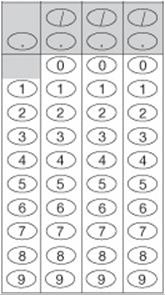
Answer Key 4: Simplifying Problems
Concept Review 4
![]()

![]()

![]()
6. Substitute ![]() into
into ![]() to get
to get ![]()


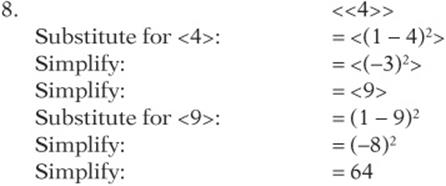
SAT Practice 4


3. D Start by simplifying the expressions:
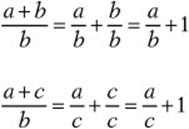
Substituting into the original equations gives
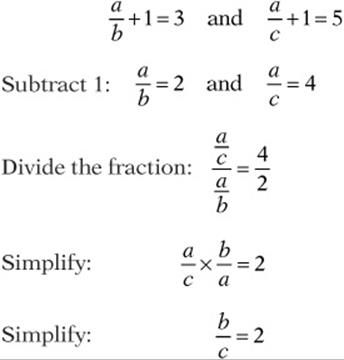
4. D Begin by simplifying ![]() by substitution:
by substitution: ![]() But be careful not to pick (A) ^1/6 because
But be careful not to pick (A) ^1/6 because ![]()
Notice that the choices must be evaluated first before we can see which one equals 1/6. Notice that choice (D) ![]()
5. 1 Begin by simplifying ^^k by substitution:

Yikes! That doesn”t look simple! But think about it: why is it that k can”t be 0? Because division by 0 is undefined, and k is in a denominator. But notice that ![]() is also in a denominator, so
is also in a denominator, so ![]() can”t be 0, either!
can”t be 0, either!
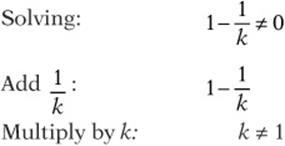
Then check by noticing that ^^1 is undefined:
![]() , and 1/0 is undefined.
, and 1/0 is undefined.